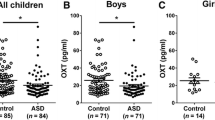Abstract
We measured CSF levels of β-endorphin, an opioid hormone, in 19 patients with infantile autism and in 3 patients with Rett syndrome, and compared them with control values. In infantile autism, CSF levels of β-endorphin did not differ significantly from those of age-matched controls. There was no significant correlation between CSF levels and clinical symptoms, including self-injurious behavior, pain insensitivity, and stereotyped movement. However, CSF levels of β-endorphin were significantly higher in the patients with Rett syndrome than in the control (p < .05). Data suggest that neurons containing β-endorphin may not be involved in patients with infantile autism. Thus, there is no relationship between dysfunction of brain opioid and autism.
Similar content being viewed by others
REFERENCES
Agid, Y., & Javoy-Agid, F. (1985). Peptides and Parkinson's disease. Trends in Neurosciences, 8, 30–35.
American Psychiatric Association. (1987). Diagnostic and statistical manual of mental disorder (3rd ed., rev., pp. 38–39). Washington, DC: Author.
Barreca, T., Siani, C., Franceschini, R., Francaviglia, N., Messina, V, Perria, C, & Rolandia, E. (1986). Diurnal beta-endorphin changes in human cerebrospinal fluid. Life Sciences, 38, 2263–2267.
Black, S. L. (1994). Naltrexone in infantile autism. Journal of Autism and Developmental Disorders, 24, 236–239.
Bloom, E., Segal, D., Ling, N., & Guillemin, R. (1976). Endorphins: profound behavioral effects in rats suggest new etiological factors in mental illness. Science, 194, 630–632
Domscher, W., Dickschas, A., & Mitznegg, P. (1979). CSF β-endorphin in schizophrenia [Letter to editor]. Lancet, 1, 1024.
Echenne, B., Bressot, N., Bassir, M., Daures, J. P., & Rabinowitz, A. (1991). Cerebrospinal fluid β-endorphin and cortisol study in Rett syndrome. Journal of Child Neurology, 6, 257–262.
Ernst, M., Devi, L., Silva, R. R., Gonzalez, N. M., Small, A. M., Malone, R. P., & Campbell, M. (1993). Plasma beta-endorphin levels, naltrexone, and haloperidol in autistic children. Psychopharmacology Bulletin, 29, 221–227.
Gillberg, C., Terenius, L., Hagberg, B., Witt-Engerström, I., & Eriksson, I. (1990). CSF beta-endorphins in childhood neuropsychiatric disorders. Brain and Development, 12 88–92.
Gillberg, C., Terenius, L, & Lönnerholm, G. (1985). Endorphin activity in childhood psychosis. Archives of General Psychiatry, 42, 780–783.
Gjerris, A., Gjerris, F., Sorensen, S. P., Sorensen, B. E., Christensen, J. N., Fahrenkrug, J., & Rehfeld, F. J. (1988). Do concentrations of neurotransmitters measured in lumbar cerebrospinal fluid reflect the concentrations at brain level? Acta Neurochirurgica (Wien), 91, 55–59.
Hagberg, B. A. (1989). Rett syndrome: Clinical peculiarities, diagnostic approach, and possible cause. Pediatric Neurology, 5, 75–83.
Hanley, H. G., Stahl, S. M., & Freedman, D. X. (1977). Hyperserotonemia and amine metabolites in autistic and retarded children. Archives of General Psychiatry, 34, 44–48.
Khachaturian, H., Lewis, M., Schäfer, M., & Watson, S. (1985). Anatomy of the CNS opioid systems. Trends in Neurosciences, 8, 111–119.
Kjaer, A., Knigge, U., Bach, F. W, & Warberg, J. (1992). Histamine and stress-induced secretion of ACTH and beta-endorphin: Involvement of corticotropin-releasing hormone and vasopressin. Neuroendocrinology, 56, 419–428.
Leboyer, M., Bouvard, M. P., & Dugas, M. (1988). Effects of naltrexone on infantile autism. Lancet, 1, 715.
Leboyer, M., Bouvard, M. P., Launay, J. M., Tabuteau, F., Waller, D., Dugas, M., Kerdelhue, B., Lensing, P., & Panksepp, J. (1992). Brief report: A double-blind study of naltrexone in infantile autism. Journal of Autism and Developmental Disorders, 22, 309–319.
Matsuishi, T, Sakai, T, Nagamitsu, S., Komori, H., Iwashita, H., & Kato, H. (1994). Decreased cerebrospinal fluid levels of β-endorphin in Japanese patients with Joseph disease. Annals of Neurology, 35, 441–443.
McQueen, D. S. (1983). Opioid peptide interactions with respiratory and circulatory systems. British Medical Bulletin, 39, 77–82.
Myer, C. E., Tripathi, L. H., Brase, A. D., & Dewey, L. W. (1992). Elevated CSF beta-endorphin immunoreactivity in Rett syndrome: Report of 158 cases and comparison with leukemic children. Neurology, 42, 357–360.
Nagamitsu, S. (1993). CSF beta-endorphin levels in pediatric neurologic disorders. Kurume Medical Journal, 40, 233–241.
Panksepp, J. (1981). Brain opioids—A neurochemical substrate for narcotic and social dependence. In S. J. Cooper (Ed.), Theory in psychopharmacology (Vol. 1). London: Academic Press.
Panksepp, J., & Sahley, T. L. (1987). Possible brain opioid involvement in disrupted social intent and language development of autism. In E. Schopler & G. Mesibov (Eds.), Neurobiological issues in autism (pp. 357–373). New York: Plenum Press.
Panksepp, J., Siviy, S. M., & Normansell, L. A. (1985). Brain opioids and social emotions. In M. Reite & T. Fields (Eds.), The psychobiology of attachment. New York: Academic Press.
Percy, A., Zoghbi, H., Lewis, K., & Jankovic, J. (1988). Rett syndrome: Qualitative and quantitative differentiation from autism. Journal of Child Neurology, 3, 65–67.
Sahley, T. L., & Panksepp, J. (1987). Brain opioids and autism: An updated analysis of possible linkages. Journal of Autism and Developmental Disorders, 17, 201–216.
Sandman, C. A., Barron, J. L., Chicz-DeMet, A., & Demet, E. M. (1991). Brief report: Plasma β-endorphin and cortisol levels in autistic patients. Journal of Autism and Developmental Disorders, 21, 83–87.
Tsumori, M., & Isobe, K. (1965). Childhood developmental evaluation test for subjects 3 to 7 years old (pp. 1–218). Tokyo: Dai Nippon Tosho Corp.
Winsberg, B. G., Sverd, J., Castell, S., Hurwic, M., & Perel, J. M. (1980). Estimation of monoamine and cyclic-AMP turnover and aminoacid concentrations of spinal fluid in autistic children. Neuropediatrics, 11, 250–255.
Yamamoto, Y., Yanaihara, C, Katsumaru, Y., Mochizuki, T., Tobe, A., Egawa, M., Imura, H., Numa, S., & Yanaihara, N. (1983). Synthesis of porcine leumorphin and some of its biological activity. Regulatory Peptides, 6, 163–168.
Author information
Authors and Affiliations
Rights and permissions
About this article
Cite this article
Nagamitsu, S., Matsuishi, T., Kisa, T. et al. CSF β-Endorphin Levels in Patients with Infantile Autism. J Autism Dev Disord 27, 155–163 (1997). https://doi.org/10.1023/A:1025839807431
Issue Date:
DOI: https://doi.org/10.1023/A:1025839807431




